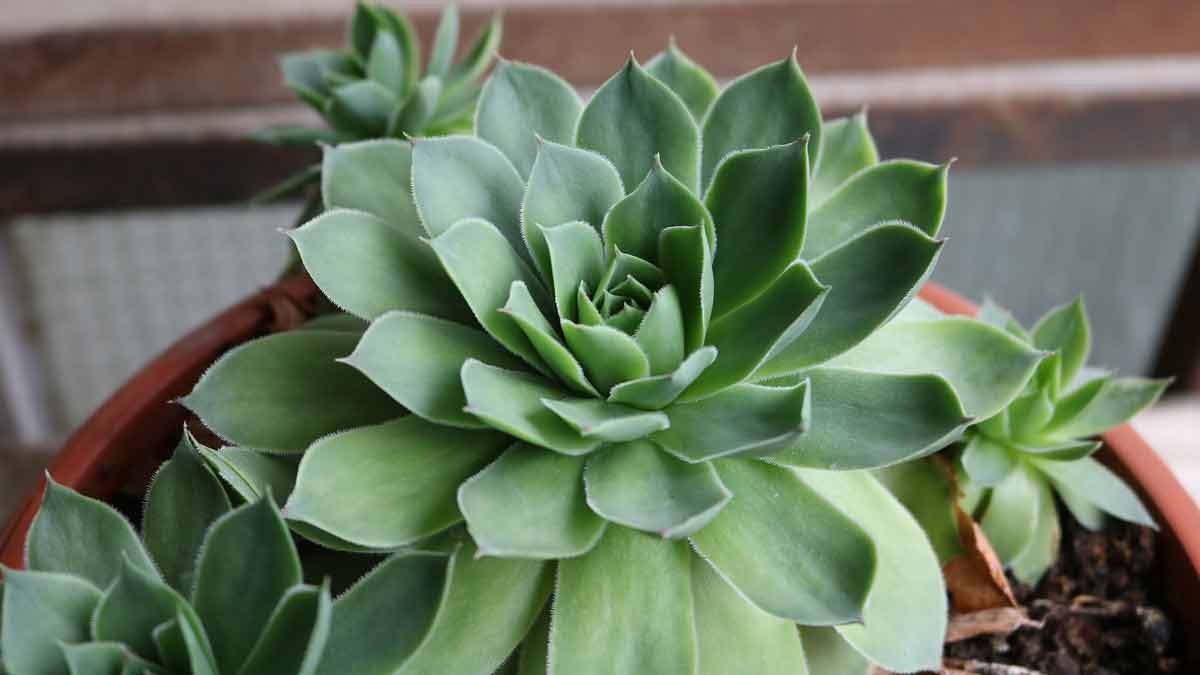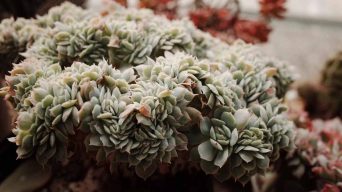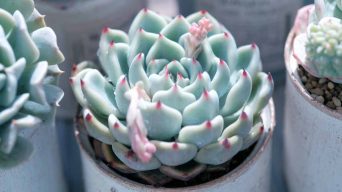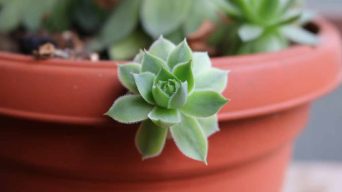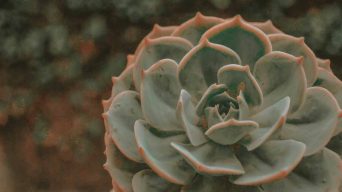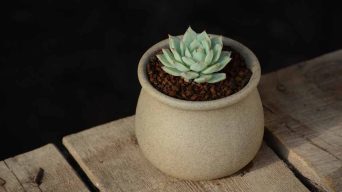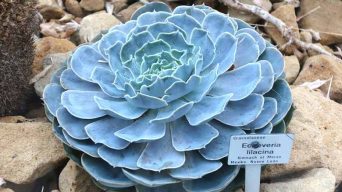Key Takeaways
- Echeveria succulents typically grow up to 12 inches in height or spread, with a slow growth rate and rosette-shaped leaves, making them ideal for indoor and outdoor gardening.
- The size of echeverias is influenced by various factors such as genetic variations, environmental conditions (especially light exposure and soil quality), nutrient availability in soil, and proper maintenance techniques like pruning and fertilization.
- Understanding the growth potential of different echeveria varieties can help you pick the right plant for your garden or collection. Varieties like Echeveria elegans are small but mighty, while the Chenille plant has growth limitations due to its woody stem and small root system. On the other hand, Echeveria peacockii offers some variation in size compared to other small succulents without taking up too much space.
Echeveria succulents, known for their stunning rosette-shaped leaves and vibrant colors, have become a popular choice among plant enthusiasts.
With over 150 species in the Echeveria genus, you may wonder how big these beautiful plants can grow.
This comprehensive guide will delve into everything you need to know about Echeverias’ growth habits, factors influencing their size, and tips for achieving optimal growth at home.
Understanding Echeveria Plant Growth
Echeveria plants have a growth pattern in the shape of a rosette, and they usually reach a height or width of up to 12 inches.
They tend to grow slowly.
Growth Habit
Echeveria succulents boast an attractive growth habit, forming stunning compact rosettes that make them ideal indoor and outdoor gardening choices.
Their plump leaves spread outward in a charming radial pattern, creating eye-catching symmetry and visual appeal to plant collections.
Although generally slow-growing plants with modest height expectations – rarely exceeding one foot in diameter or height – Echeveria plants exhibit some flexibility regarding sunlight exposure.
These hardy succulents can thrive in direct sunlight and partial shade, making them versatile options for gardeners with varying light conditions.
Typical Size Of Echeveria Succulents
Echeveria succulents are well-known for their charming, rosette-shaped growth patterns and compact form.
Interestingly, most Echeverias typically grow to a height or spread of approximately 12 inches (31 cm), making them an appealing choice among plant enthusiasts seeking low-maintenance houseplants.
The diverse range in size across different Echeveria species allows individuals to select plants that best suit their particular aesthetic preferences or available garden space constraints.
For instance, the popular Echeveria elegans or “Mexican snowball” typically remains under one foot in both diameter and height – an ideal option for those looking to incorporate this segment into smaller spaces like windowsills and desks at home.
Growth Rate
Echeveria succulents are known for their slow growth rate, which can be both a blessing and a challenge for plant owners.
Understanding your Echeveria’s natural growth process is essential to provide them with the optimal care they need to thrive.
It could be helpful to track your plant’s progress by measuring its size periodically throughout the year or taking photos regularly.
By doing so, you will become better acquainted with your succulent’s unique growing habits and be able to make informed decisions regarding any necessary adjustments in care and maintenance routines.
Factors Influencing The Size Of Echeveria
An Echeveria’s size is determined by various factors, including genetic variations, environmental conditions, soil nutrient availability, and the amount of light needed for optimal growth.
Genetic Variations
Genetic variations can influence the size and growth rate of Echeveria succulents.
Different varieties of Echeveria have different genetic traits that affect their maximum size and appearance.
For instance, some varieties have smaller rosettes while others have larger ones.
Some Echeverias may produce flowers on tall stalks, while others bloom close to the ground.
Furthermore, mutation breeding has shown promising results in producing desirable ornamental attributes and environmental tolerance in Echeveria plants.
Environmental Conditions
Various environmental conditions can influence the size of Echeveria plants.
For instance, the amount and intensity of sunlight exposure the plant receives can significantly affect its growth rate.
These succulents thrive in sunny locations, so placing them in a spot with direct sunlight is crucial in promoting optimal growth and size.
Additionally, the type of soil used can impact the plant’s nutrient intake and ultimately determine its overall health and size.
Nutrient Availability In Soil
Proper soil quality is vital for the growth of Echeveria succulents, as nutrient availability in the soil can significantly affect their size and overall health.
One way to ensure your Echeveria succulent gets enough nutrients is by using a high-quality potting mix formulated for cacti and succulents.
These mixes often contain perlite or vermiculite to improve drainage and prevent waterlogging while also providing essential minerals and trace elements needed for proper plant growth.
Another method is fertilizing them every few months with a low-nitrogen liquid fertilizer diluted at half strength.
Amount Of Light Required
Adequate light is the key to growing healthy and robust Echeveria succulents.
These desert plants are accustomed to thriving in bright sun, so ensuring your Echeveria receives plenty of direct sunlight daily is essential.
If your Echeveria isn’t getting enough light, you’ll notice it will grow more slowly or even stop growing altogether.
One way to ensure optimal growth is by placing your Echeveria near an east- or west-facing window that can soak up some rays during the day but avoid intense mid-day sun that can damage its leaves.
Another option is using artificial grow lights if you don’t have access to adequate natural light sources.
Size Of Different Echeveria Varieties
Learn about the maximum size of different echeveria varieties and which ones have growth limitations – you might be surprised!
Maximum Size Of Echeveria Elegans
Echeveria elegans is a small, slow-growing succulent that typically reaches a maximum height of 6 inches and a diameter of 12 inches.
This variety has tight rosettes with silvery-green leaves that get slightly pinkish in direct sunlight.
One interesting fact about this small but mighty succulent is that its size varies greatly depending on the conditions where it’s grown.
If planted in rich soil, provided adequate sunlight, and watered regularly, Echeveria elegans can reach its full potential size within two years.
Growth Limitations Of Echeveria Pulvinata
Echeveria pulvinata, also known as the Chenille plant, is a stunning species of Echeveria.
While this variety adds height and color to succulent arrangements, it has growth limitations that result in a smaller overall size.
Due to its woody stem and small root system, Echeveria pulvinata typically grows no more than 6 inches in diameter.
Though it may not be as large as other varieties of Echeveria plants, its unique characteristics make it an excellent addition to any collection.
Size Comparison Of Echeveria Peacockii
Echeveria peacockii is a beautiful succulent that can add a touch of elegance to any garden or indoor space.
This plant can grow up to six inches in diameter, making it one of the larger varieties of Echeveria succulents.
Compared to other Echeveria plants, such as the tiny Echeveria Lola and the much larger Echeveria elegans, this size range puts Echeveria peacockii right in the middle.
If you want to add a burst of vibrant colors to your garden indoors and outdoors without taking up much space, consider including an Echeveria peacockii plant in your collection.
Unlike small succulents like Echeverias Lola or the Ghost Echeveria, this plant offers some size variation.
Other Varieties Of Echeveria And Their Maximum Sizes
Echeveria comes in a wide variety of shapes and sizes, each with unique features.
Echeveria colorata is known for its stunning violet leaves and can grow up to 8 inches in diameter.
Another popular variety is Echeveria peacockii, which forms compact rosettes and can reach a height of 6 inches tall by 12 inches wide.
The Echeveria purpusorum typically grows up to 4-5 centimeters tall but produces beautiful yellow ends on its pinkish-red flower stalks.
Meanwhile, the Mexican gem or white Mexican snowball has huge bloom stalks that can reach heights of 8-12 inches tall with pink blooms.
Tips For Achieving Optimal Echeveria Growth And Size
For your Echeveria plant to grow to its optimal size, use a potting mix that drains well and contains perlite or sand.
Water the plant thoroughly but sparingly when the soil is dry. Give your plant at least 6 hours of sunlight, or use grow lights.
Fertilize once a month during the growing season with a balanced liquid fertilizer diluted by half.
To promote new growth, regularly remove dead leaves and offsets.
Proper Care And Maintenance Techniques
Proper care and maintenance techniques are crucial to ensure optimal growth and size for your Echeveria succulents.
The first step is to water them moderately, as overwatering can lead to root rot.
It’s also important to provide the right potting medium using a mix of soil and perlite that allows good drainage while providing enough nutrients for healthy growth.
Additionally, ensure they get enough but not direct sunlight, especially during hot afternoons.
Lastly, regular feeding with liquid fertilizer can help maintain their vibrant foliage colors and promote blooming in some echeveria varieties.
Importance Of Soil Quality And Correct Watering
To achieve optimal growth and size for your Echeveria succulent, paying close attention to the quality of soil you use and how you water your plant is crucial.
Well-draining soil that dries out quickly is essential to prevent moisture buildup, which can lead to root rot or other diseases.
When watering your Echeveria, avoid overwatering as this can lead to pests like mealybugs or root rot.
Generally, Echeverias can be watered once every week to ten days, depending on the plant size and pot.
It’s important not to leave standing water in saucers underneath pots as this can also contribute to excess moisture accumulation around roots.
Pruning And Propagation Methods
To keep your Echeveria succulents healthy and to look their best, it’s important to know how to prune them properly.
Regular pruning can help prevent pests and diseases, promote new growth, and maintain the plant’s shape.
To start pruning, remove any dead or damaged leaves by gently pulling them off at the base of the stem.
Propagation Methods
Growing Echeveria plants also involves tending to their propagation, which is a crucial aspect.
These plants are relatively easy to propagate using several methods, such as leaf cuttings, stem cuttings, offsets, or sowing seeds.
Leaves Cuttings
Propagating plants through leaf cutting is a simple process:
- Carefully pluck a leaf from an existing plant, keeping its base intact.
- Let the leaf dry in a shaded area until it forms a callous, then insert the end into a well-draining soil mix.
- Water the soil once every three weeks and provide indirect light until the roots grow to about 1/4 inch in length.
- Gradually move the plant to direct sunlight over time.
Stem Cuttings
To propagate a plant through stem cutting, you must take a piece of stem from an existing plant with some leaves attached.
Then, insert it into the soil and wait for rooting.
Once the roots have formed, you can pot the new plant.
Offsets
To propagate offset, you must carefully detach the offshoots from the mature plant’s base without causing any damage.
Then, you can plant these separated “heads” directly into the prepared soil.
It is important to provide them with ample sunlight but limit their water intake until they are established (which usually takes around a month).
Seeds
Growing Echeveria plants from seeds require patience, but it’s a straightforward process.
Scatter the dried echeveria seed pod contents onto a well-draining soil mix in favorable conditions.
Within weeks, the seeds will germinate, and once the seedlings reach a reasonable size after a few months, they can be transferred to a new location.
The Role Of Fertilizers And Nutrient Supplements
Fertilizers and nutrient supplements are crucial in promoting healthy growth and enhancing the appearance of echeveria succulents.
As with any plant, providing the right balance of nutrients is essential to encourage optimal growth.
For instance, a high-phosphorus fertilizer formula like 5-10-5 or 10-15 can improve flowering.
It’s best to apply fertilizer during the growing season, typically from late winter until summer, when the plant is actively growing.
If you’re unsure which type of fertilizer best suits your echeveria variety, consult with experienced gardeners for advice on how frequent and what type works best for your plants.
Light Requirements For Optimal Growth
Providing the appropriate amount of light is essential to achieve optimal growth and size for your Echeveria succulents.
These plants require full sun to properly develop and thrive, meaning they need at least six hours of direct sunlight daily.
If you live in an area with insufficient natural light or limited outdoor space, consider placing your Echeveria plant near an east or west-facing window indoors.
This option will ensure your plant gets enough indirect sunlight throughout the day.
Always rotate your Echeveria regularly so that each side receives uniform light coverage.
Final Thoughts
Understanding the growth habit and environmental factors that influence the size of your echeveria succulent is crucial in achieving optimal growth.
While some species can grow into small shrub-like plants up to 2 feet tall, most echeverias only reach a height or spread of around 12 inches.
Proper care and maintenance techniques such as well-draining soil, correct watering, pruning, and fertilization are essential for healthy echeveria growth.
With these tips in mind, you can easily create a beautiful indoor or outdoor garden filled with plump leaves and pastel-colored flowers.

